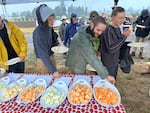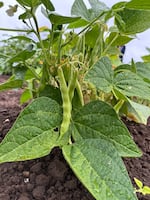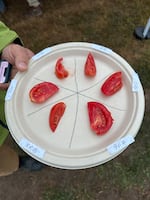
From left, farmers Katie Gourley, David Oberstein and Julia Forsyth sample dry-farmed melons grown at Oregon State University's Vegetable Research Farm in Corvallis, Ore., on Aug. 31, 2023.
Crystal Ligori / OPB
On an unusually rainy August afternoon, about 40 people were huddled under a pair of tents on the edge of Oregon State University’s Vegetable Research Farm. The group of farmers, researchers and home gardeners had made its way to Corvallis to learn more about a technique called dry farming.
“We have a couple acres of land and we’re looking for what suitable crops would be to grow on it,” said home gardener Lauren.
She and her husband, Tim, have only had their property for a year, and he said part of their interest in dry farming is the desire to streamline the process. “We’re not there all the time, so if we have to water less, that’s great,” Tim said.
A simplified definition of dry farming is growing crops without irrigation, relying only on the moisture stored in the soil. It’s most successful in regions with at least 20 inches of annual rainfall, and it’s a technique that’s been used around the world for centuries.
“The Hopi in Arizona, [people] in the Mediterranean … There’s just a lot of places and examples throughout the world where people have grown food without irrigation,” said Amy Garrett, founder of the Dry Farming Institute. “And they didn’t even call it dry farming — they were just farming, using what they had to grow food.”

Dry-farmed green beans growing at Oregon State University's Vegetable Research Farm in Corvallis, Ore., on Aug. 31, 2023.
Crystal Ligori / OPB
Garrett explained that since growers are all in a different situation in regards to irrigation, the Dry Farming Institute expands on the definition, calling it a “low-input, place-based approach to producing crops within the constraints of your climate.” Agriculture irrigation accounts for 70% of water use worldwide and as access to that water becomes increasingly complex, even more farmers are taking notice.
“I think the folks that are more interested in exploring dry farming have already experienced some water limitations,” said Garrett. “Or they have values like, ‘While I have access to water to irrigate, I don’t know that my kids are gonna have access to water to irrigate.’”
Garrett’s interest in dry farming started in 2011, when she was working with first-time farmers in OSU’s Small Farms Program. And they had a lot of questions: everything from recognizing soil types to what crops they should grow. But something that kept coming up was water rights, or more specifically, a lack thereof.
“In a lot of cases they were on lands that had limited water access or did not have water rights,” said Garrett. “For a lot of new and beginning farmers, land access is already an issue and in a lot of cases, there’s not great water access where they are finding land opportunities to grow.”

Amy Garrett packs up dry farmed tomato varieties for attendees of the third annual Tomato Fest in Portland, Ore., Sept. 11, 2023. Garrett is the founder of the Dry Farming Institute and has been sharing knowledge about the growing practice since 2011.
Crystal Ligori / OPB
Garrett recognized how much of a hurdle water was for those farmers, so in 2015 she connected with a California-based nonprofit to learn more.
“I knew there were people dry farming down in California and they helped to connect me with five or six farmers,” said Garrett. “I did a visit down there to look at what crops are being grown without irrigation, what techniques were being used.”
Garrett wanted to share that newly acquired knowledge with farmers back in Oregon, so later that year she implemented OSU’s first Dry Farming Demonstration. That summer, the entire state was in severe or extreme drought, so conditions for real-world usage of the technique were ideal.
“A lot of people came to that field day and were surprised that there was anything growing out there,” said Garrett. “And they were asking questions like, ‘OK, well, how many times did you irrigate here?’ And I was explaining, we didn’t irrigate. And people were sort of just flabbergasted.”
Those real-world trails are essential, not just for the farmers, but also for plant and seed breeders like Jared Zystro who’s based in Arcata, California.
“One of the questions when you’re doing plant breeding is: Am I selecting this plant or these plants because they actually have something special about them genetically?” Zystro said. “Or am I just seeing something that’s related to the very specific micro-environment that the plant’s experiencing that makes it look better?”
Essentially, the on-farm trials give researchers the opportunity to plant the same seed over and over in different soils and conditions in order to get an idea of how the plant is adapting.
“Some plants’ root architecture might point more downward, rather than really being wide and shallow rooted, and be able to tap into the moisture as it’s sort of retreating in the soil as the wet spring soil dries into drier summer soil,” he said.

Dry-farmed tomatoes growing at Oregon State University's Vegetable Research Farm in Corvallis, Ore., on Aug. 31, 2023.
Crystal Ligori / OPB
As the co-director of research and education for the Organic Seed Alliance, Zystro said these new dry-farmed crop varieties could also be key to helping agriculture of all types in the future.
“The prime, best agricultural land is often being held intergenerationally or by the largest commercial production,” he said. “So for many organic farmers, they’re working with whatever ground they can get access to and often that might mean they don’t have water rights or water is in a limited supply.”
Even as climate change makes weather patterns more erratic and access to water becomes more politicized, Zystro says we still need to find ways to grow these crops.
“Being able to either identify and develop crops that can grow with much more limited access to water and without potentially supplemental water allows us to be able to continue to grow good food into the future,” he said. “That’s something that is really important.”

A plate of dry-farmed tomatoes is sampled and rated at Oregon State University's Vegetable Research Farm in Corvallis, Ore., Aug. 31, 2023.
Crystal Ligori / OPB
Earlier this year, American Farmland Trust was awarded a $1.3 million grant to facilitate a multi-year project across Oregon, Washington and California to look at regional approaches to “food system resilience to drought and climate instability.”
“We’re partnering with multiple growers, organizations and tribes in that project to elevate their approach to water resilient strategies,” she said. “And doing a lot of storytelling to amplify examples of what this looks like in different contexts.”
Over the next three years, the Dry Farming Institute along with Oregon State University, the Washington Water Trust and other climate leaders in the Pacific Northwest will focus on sharing scalable climate-smart farming practices and on-farm learning events in hopes to get even more folks on the dry farm bandwagon.


